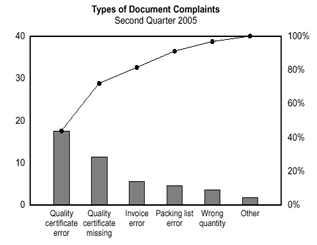Teaching:TUW - UE InfoVis WS 2008/09 - Gruppe 10 - Aufgabe 1 - Pareto Chart
Pareto Chart[edit]
Definition[edit]

Pareto Principle[edit]
The Pareto principle (also known as "the 80-20 rule", "the law of the vital few" and "the principle of factor sparsity") states that, for many events, 80% of the effects come from 20% of the causes. Business management thinker Joseph M. Juran suggested the principle and named it after Italian economist Vilfredo Federico Damaso Pareto , who observed that 80% of income in Italy went to 20% of the population. It is a common rule of thumb in business; e.g., "80% of your sales comes from 20% of your clients."
Statistical and Mathematical Explanation[edit]
A histogram is a graphical representation of the frequency distribution of the data. In pareto context the data has to be ordered in a descendant way in order to match the pareto principle.
The curved graph in the Pareto Chart is actually а total frequency polygon, which is widely used in statistics. It is built by connecting the total percentage frequencies on the right edge of the bars in the histogram to each other. [Dutter, 2008]
Fields of use[edit]
The Pareto Chart could be used in many fields and aspects since it is a blueprint of a general principle. However it is most commonly referenced in the following contexts:
- QC/QM - Quality Control/Quality Management
- Microeconomics
- Statistics
Example[edit]
The following pareto chart is a short example of the Pareto problem. The chart lists the types of document complaints in a company. As you can see the sum of the first two types of complaints goes almost up to 80%. So you can basically say, that 30% (2 from 6 types) of the causes lead to 80% of the complaints in that particular company.

History[edit]
Vilfredo Federico Damaso Pareto (July 15, 1848 – August 19, 1923), or Fritz Wilfried Pareto, was an Italian sociologist, economist, and philosopher. He introduced the concept of Pareto efficiency and helped develop the field of microeconomics. In 1906, he made the famous observation that twenty percent of the population owned eighty percent of the property in Italy, later generalised by Joseph M. Juran and others into the so-called Pareto principle (also termed the 80-20 rule) and generalised further to the concept of a Pareto distribution.
Bibliography[edit]
[Koch, 2004] Richard Koch. Living the 80/20 Way: Work Less, Worry Less, Succeed More, Enjoy More. Nicholas Brealey Publishing, London 2004. ISBN 1857883314.
[Eisermann, 2004] G. Eisermann. "Pareto, Vilfredo 1848–1923," International Encyclopedia of the Social & Behavioral Sciences, pp. 11048-11051. Abstract 2004.
[Dutter, 2008] Rudolf Dutter. Statistik und Wahrscheinlichkeitsrechnung für InformatikerInnen, Scriptum, Vienna University of Technology, 2008, pp. 18-25.
[Tague, 2005] Nancy R. Tague. The Quality Toolbox, Second Edition. ASQ Quality Press, ISBN 0873896394, pp. 376-378.